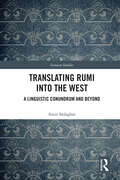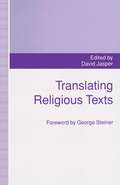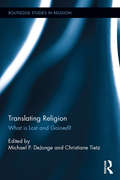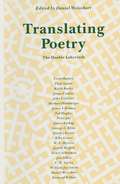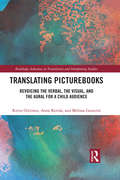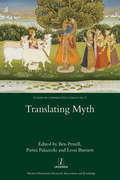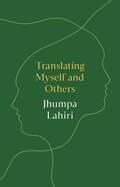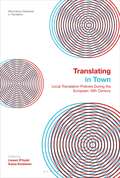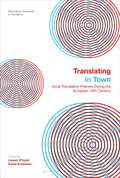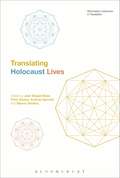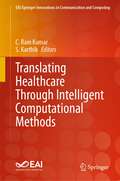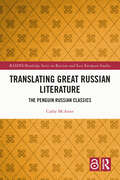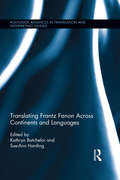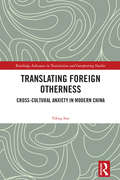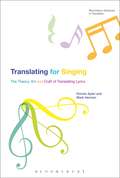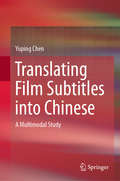- Table View
- List View
Translating Rumi into the West: A Linguistic Conundrum and Beyond (Iranian Studies)
by Amir SedaghatFocusing on Rumi, the best-selling Persian mystical poet of the 13th century, this book investigates the reception of his work and thought in North America and Europe – and the phenomenon of ‘Rumimania’ – to elucidate the complexities of intercultural communication between the West and the Iranian and Islamic worlds. Presenting tens of examples from the original and translated texts, the book is a critical analysis of various dimensions of this reception, outlining the difficulties of translating the text but also exploring how translators of various times and languages have performed, and explaining why the quality of reception varies. Topics analysed include the linguistic and pragmatic issues of translation, comparative stylistics and poetics, and non-textual factors like the translator’s beliefs and the political and ideological aspects of translation. Using a broad theoretical framework, the author highlights the difficulties of intercultural communication from linguistic, semiotic, stylistic, poetic, ethical, and sociocultural perspectives. Ultimately, the author shares his reflections on the semiotic specificities of Rumi’s mystical discourse and the ethics of translation generally. The book will be valuable to scholars and students of Islamic philosophy, Iranian studies, and translation studies, but will appeal to anyone interested in the cultural dichotomies of the West and Islam.
Translating Rumi into the West: A Linguistic Conundrum and Beyond (Iranian Studies)
by Amir SedaghatFocusing on Rumi, the best-selling Persian mystical poet of the 13th century, this book investigates the reception of his work and thought in North America and Europe – and the phenomenon of ‘Rumimania’ – to elucidate the complexities of intercultural communication between the West and the Iranian and Islamic worlds. Presenting tens of examples from the original and translated texts, the book is a critical analysis of various dimensions of this reception, outlining the difficulties of translating the text but also exploring how translators of various times and languages have performed, and explaining why the quality of reception varies. Topics analysed include the linguistic and pragmatic issues of translation, comparative stylistics and poetics, and non-textual factors like the translator’s beliefs and the political and ideological aspects of translation. Using a broad theoretical framework, the author highlights the difficulties of intercultural communication from linguistic, semiotic, stylistic, poetic, ethical, and sociocultural perspectives. Ultimately, the author shares his reflections on the semiotic specificities of Rumi’s mystical discourse and the ethics of translation generally. The book will be valuable to scholars and students of Islamic philosophy, Iranian studies, and translation studies, but will appeal to anyone interested in the cultural dichotomies of the West and Islam.
Translating Religious Texts: Translation, Transgression and Interpretation
by D. Jasper George SteinerTranslating Religion: What is Lost and Gained? (Routledge Studies in Religion)
by Michael DeJonge Christiane TietzTranslating Religion advances thinking about translation as a critical category in religious studies, combining theoretical reflection about processes of translation in religion with focused case studies that are international, interdisciplinary, and interreligious. By operating with broad conceptions of both religion and translation, this volume makes clear that processes of translation, broadly construed, are everywhere in both religious life and the study of religion; at the same time, the theory and practice of translation and the advancement of translation studies as a field has developed in the context of concerns about the possibility and propriety of translating religious texts. The nature of religions as living historical traditions depends on the translation of religion from the past into the present. Interreligious dialogue and the comparative study of religion require the translation of religion from one tradition to another. Understanding the historical diffusion of the world’s religions requires coming to terms with the success and failure of translating a religion from one cultural context into another. Contributors ask what it means to translate religion, both textually and conceptually, and how the translation of religious content might differ from the translation of other aspects of human culture. This volume proposes that questions on the nature of translation find particularly acute expression in the domains of religion, and argues that theoretical approaches from translation studies can be fruitfully brought to bear on contemporary religious studies.
Translating Religion: What is Lost and Gained? (Routledge Studies in Religion)
by Christiane Tietz Michael P. DeJongeTranslating Religion advances thinking about translation as a critical category in religious studies, combining theoretical reflection about processes of translation in religion with focused case studies that are international, interdisciplinary, and interreligious. By operating with broad conceptions of both religion and translation, this volume makes clear that processes of translation, broadly construed, are everywhere in both religious life and the study of religion; at the same time, the theory and practice of translation and the advancement of translation studies as a field has developed in the context of concerns about the possibility and propriety of translating religious texts. The nature of religions as living historical traditions depends on the translation of religion from the past into the present. Interreligious dialogue and the comparative study of religion require the translation of religion from one tradition to another. Understanding the historical diffusion of the world’s religions requires coming to terms with the success and failure of translating a religion from one cultural context into another. Contributors ask what it means to translate religion, both textually and conceptually, and how the translation of religious content might differ from the translation of other aspects of human culture. This volume proposes that questions on the nature of translation find particularly acute expression in the domains of religion, and argues that theoretical approaches from translation studies can be fruitfully brought to bear on contemporary religious studies.
Translating Poetry: The Double Labyrinth
by Daniel WeissbortThis volume, with contributions in the form of narrations, or of work sheets, by leading British and American translators, shows what happens: how problems present themselves and how they are resolved.
Translating Picturebooks: Revoicing the Verbal, the Visual and the Aural for a Child Audience (Routledge Advances in Translation and Interpreting Studies)
by Riitta Oittinen Anne Ketola Melissa GaraviniTranslating Picturebooks examines the role of illustration in the translation process of picturebooks and how the word-image interplay inherent in the medium can have an impact both on translation practice and the reading process itself. The book draws on a wide range of picturebooks published and translated in a number of languages to demonstrate the myriad ways in which information and meaning is conveyed in the translation of multimodal material and in turn, the impact of these interactions on the readers’ experiences of these books. The volume also analyzes strategies translators employ in translating picturebooks, including issues surrounding culturally-specific references and visual and verbal gaps, and features a chapter with excerpts from translators’ diaries written during the process. Highlighting the complex dynamics at work in the translation process of picturebooks and their implications for research on translation studies and multimodal material, this book is an indispensable resource for students and researchers in translation studies, multimodality, and children’s literature.
Translating Picturebooks: Revoicing the Verbal, the Visual and the Aural for a Child Audience (Routledge Advances in Translation and Interpreting Studies)
by Riitta Oittinen Anne Ketola Melissa GaraviniTranslating Picturebooks examines the role of illustration in the translation process of picturebooks and how the word-image interplay inherent in the medium can have an impact both on translation practice and the reading process itself. The book draws on a wide range of picturebooks published and translated in a number of languages to demonstrate the myriad ways in which information and meaning is conveyed in the translation of multimodal material and in turn, the impact of these interactions on the readers’ experiences of these books. The volume also analyzes strategies translators employ in translating picturebooks, including issues surrounding culturally-specific references and visual and verbal gaps, and features a chapter with excerpts from translators’ diaries written during the process. Highlighting the complex dynamics at work in the translation process of picturebooks and their implications for research on translation studies and multimodal material, this book is an indispensable resource for students and researchers in translation studies, multimodality, and children’s literature.
Translating Myth (Legenda)
by Ben Pestell Pietra Palazzolo Le On BurnettEver since Odysseus heard tales of his own exploits being retold among strangers, audiences and readers have been alive to the complications and questions arising from the translation of myth. How are myths taken and carried over into new languages, new civilizations, or new media? An international group of scholars is gathered in this volume to present diverse but connected case studies which address the artistic and political implications of the changing condition of myth – this most primal and malleable of forms. ‘Translation’ is treated broadly to encompass not only literary translation, but also the transfer of myth across cultures and epochs. In an age when the spiritual world is in crisis, Translating Myth constitutes a timely exploration of myth’s endurance, and represents a consolidation of the status of myth studies as a discipline in its own right.
Translating Myth (Legenda)
by Ben Pestell Pietra Palazzolo Leon BurnettEver since Odysseus heard tales of his own exploits being retold among strangers, audiences and readers have been alive to the complications and questions arising from the translation of myth. How are myths taken and carried over into new languages, new civilizations, or new media? An international group of scholars is gathered in this volume to present diverse but connected case studies which address the artistic and political implications of the changing condition of myth – this most primal and malleable of forms. ‘Translation’ is treated broadly to encompass not only literary translation, but also the transfer of myth across cultures and epochs. In an age when the spiritual world is in crisis, Translating Myth constitutes a timely exploration of myth’s endurance, and represents a consolidation of the status of myth studies as a discipline in its own right.
Translating Myself and Others
by Jhumpa LahiriLuminous essays on translation and self-translation by the award-winning writer and literary translatorTranslating Myself and Others is a collection of candid and disarmingly personal essays by Pulitzer Prize–winning author Jhumpa Lahiri, who reflects on her emerging identity as a translator as well as a writer in two languages.With subtlety and emotional immediacy, Lahiri draws on Ovid’s myth of Echo and Narcissus to explore the distinction between writing and translating, and provides a close reading of passages from Aristotle’s Poetics to talk more broadly about writing, desire, and freedom. She traces the theme of translation in Antonio Gramsci’s Prison Notebooks and takes up the question of Italo Calvino’s popularity as a translated author. Lahiri considers the unique challenge of translating her own work from Italian to English, the question “Why Italian?,” and the singular pleasures of translating contemporary and ancient writers.Featuring essays originally written in Italian and published in English for the first time, as well as essays written in English, Translating Myself and Others brings together Lahiri’s most lyrical and eloquently observed meditations on the translator’s art as a sublime act of both linguistic and personal metamorphosis.
Translating in Town: Local Translation Policies During the European 19th Century (Bloomsbury Advances in Translation)
by LievenKaisa D’hulst KoskinenTranslating in Town uncovers administrative and cultural multilingualism and translation practices in multilingual European communities during the long 19th century. Challenging the traditional narrative of nationalist, monolingual language ideologies, this book focuses instead upon translation policies which aimed to accommodate complex language situations with new democratic principles at local levels. Covering a time-frame from 1785 to 1914, chapters investigate towns and cities in the heartland of Europe, such as Barcelona, Milan and Vienna, as well as those on its outer rim, including Nicosia, Cork and Tampere. Highlighting the conflicts and negotiations that took place between official language(s), local language(s) and translation, the book explores the impact on both represented and non-represented monolingual and multilingual citizens. In so doing, Translating in Town highlights the subtle compromises obtained between official monolingualism, multilingualism and translation, and between competing views on official and private translation and transfer techniques, during this fascinating era of European history.
Translating in Town: Local Translation Policies During the European 19th Century (Bloomsbury Advances in Translation)
Translating in Town uncovers administrative and cultural multilingualism and translation practices in multilingual European communities during the long 19th century. Challenging the traditional narrative of nationalist, monolingual language ideologies, this book focuses instead upon translation policies which aimed to accommodate complex language situations with new democratic principles at local levels. Covering a time-frame from 1785 to 1914, chapters investigate towns and cities in the heartland of Europe, such as Barcelona, Milan and Vienna, as well as those on its outer rim, including Nicosia, Cork and Tampere. Highlighting the conflicts and negotiations that took place between official language(s), local language(s) and translation, the book explores the impact on both represented and non-represented monolingual and multilingual citizens. In so doing, Translating in Town highlights the subtle compromises obtained between official monolingualism, multilingualism and translation, and between competing views on official and private translation and transfer techniques, during this fascinating era of European history.
Translating Holocaust Lives (Bloomsbury Advances in Translation)
by Jean Boase-Beier Peter Davies Andrea Hammel Marion WintersFor readers in the English-speaking world, almost all Holocaust writing is translated writing. Translation is indispensable for our understanding of the Holocaust because there is a need to tell others what happened in a way that makes events and experiences accessible – if not, perhaps, comprehensible – to other communities.Yet what this means is only beginning to be explored by Translation Studies scholars. This book aims to bring together the insights of Translation Studies and Holocaust Studies in order to show what a critical understanding of translation in practice and context can contribute to our knowledge of the legacy of the Holocaust. The role translation plays is not just as a facilitator of a semi-transparent transfer of information. Holocaust writing involves questions about language, truth and ethics, and a theoretically informed understanding of translation adds to these questions by drawing attention to processes of mediation and reception in cultural and historical context. It is important to examine how writing by Holocaust victims, which is closely tied to a specific language and reflects on the relationship between language, experience and thought, can (or cannot) be translated. This volume brings the disciplines of Holocaust and Translation Studies into an encounter with each other in order to explore the effects of translation on Holocaust writing. The individual pieces by Holocaust scholars explore general, theoretical questions and individual case studies, and are accompanied by commentaries by translation scholars.
Translating Holocaust Lives (Bloomsbury Advances in Translation)
by Jean Boase-Beier Peter Davies Andrea Hammel Marion WintersFor readers in the English-speaking world, almost all Holocaust writing is translated writing. Translation is indispensable for our understanding of the Holocaust because there is a need to tell others what happened in a way that makes events and experiences accessible – if not, perhaps, comprehensible – to other communities.Yet what this means is only beginning to be explored by Translation Studies scholars. This book aims to bring together the insights of Translation Studies and Holocaust Studies in order to show what a critical understanding of translation in practice and context can contribute to our knowledge of the legacy of the Holocaust. The role translation plays is not just as a facilitator of a semi-transparent transfer of information. Holocaust writing involves questions about language, truth and ethics, and a theoretically informed understanding of translation adds to these questions by drawing attention to processes of mediation and reception in cultural and historical context. It is important to examine how writing by Holocaust victims, which is closely tied to a specific language and reflects on the relationship between language, experience and thought, can (or cannot) be translated. This volume brings the disciplines of Holocaust and Translation Studies into an encounter with each other in order to explore the effects of translation on Holocaust writing. The individual pieces by Holocaust scholars explore general, theoretical questions and individual case studies, and are accompanied by commentaries by translation scholars.
Translating Healthcare Through Intelligent Computational Methods (EAI/Springer Innovations in Communication and Computing)
by C. Ram Kumar S. KarthikThis book provides information on interdependencies of medicine and telecommunications engineering and how Covid exemplifies how the two must rely on each other to effectively function in this era. The book discusses new techniques for medical service improvisation such as clear cut views on medical technologies. The authors provide chapters on processing of medical amenities using medical images, the importance of data and information technology in medicine, and machine learning and artificial intelligence in healthcare. Authors include researchers, academics, and professionals in the field of communications engineering with a variety of perspectives.
Translating Great Russian Literature: The Penguin Russian Classics (ISSN)
by Cathy McAteerLaunched in 1950, Penguin’s Russian Classics quickly progressed to include translations of many great works of Russian literature and the series came to be regarded by readers, both academic and general, as the de facto provider of classic Russian literature in English translation, the legacy of which reputation resonates right up to the present day. Through an analysis of the individuals involved, their agendas, and their socio-cultural context, this book, based on extensive original research, examines how Penguin’s decisions and practices when translating and publishing the series played a significant role in deciding how Russian literature would be produced and marketed in English translation. As such the book represents a major contribution to Translation Studies, to the study of Russian literature, to book history and to the history of publishing.
Translating Great Russian Literature: The Penguin Russian Classics (ISSN)
by Cathy McAteerLaunched in 1950, Penguin’s Russian Classics quickly progressed to include translations of many great works of Russian literature and the series came to be regarded by readers, both academic and general, as the de facto provider of classic Russian literature in English translation, the legacy of which reputation resonates right up to the present day. Through an analysis of the individuals involved, their agendas, and their socio-cultural context, this book, based on extensive original research, examines how Penguin’s decisions and practices when translating and publishing the series played a significant role in deciding how Russian literature would be produced and marketed in English translation. As such the book represents a major contribution to Translation Studies, to the study of Russian literature, to book history and to the history of publishing.
Translating Frantz Fanon Across Continents and Languages: Frantz Fanon Across Continents and Languages (Routledge Advances in Translation and Interpreting Studies)
by Kathryn Batchelor Sue-Ann HardingThis book provides an innovative look at the reception of Frantz Fanon’s texts, investigating how, when, where and why these—especially his seminal Les Damnés de la Terre (1961) —were first translated and read. Building on renewed interest in the author’s works in both postcolonial studies and revolutionary movements in recent years, as well as travelling theory, micro-history and histoire croisée interests in Translation Studies, the volume tells the stories of translations of Fanon’s texts into twelve different languages – Arabic, Danish, English, German, Italian, Norwegian, Persian, Polish, Russian, Serbo-Croatian, Swahili and Swedish – bringing both a historical and multilingual perspective to the ways in which Fanon is cited today. With contributions from an international, interdisciplinary group of scholars, the stories told combine themes of movement and place, personal networks and agency, politics and activism, archival research and textual analysis, creating a book that is a fresh and comprehensive volume on the translated works of Frantz Fanon and essential reading for scholars in translation studies, postcolonial studies, cultural studies, critical race studies, and African and African diaspora literature.
Translating Frantz Fanon Across Continents and Languages: Frantz Fanon Across Continents and Languages (Routledge Advances in Translation and Interpreting Studies)
by Kathryn Batchelor Sue-Ann HardingThis book provides an innovative look at the reception of Frantz Fanon’s texts, investigating how, when, where and why these—especially his seminal Les Damnés de la Terre (1961) —were first translated and read. Building on renewed interest in the author’s works in both postcolonial studies and revolutionary movements in recent years, as well as travelling theory, micro-history and histoire croisée interests in Translation Studies, the volume tells the stories of translations of Fanon’s texts into twelve different languages – Arabic, Danish, English, German, Italian, Norwegian, Persian, Polish, Russian, Serbo-Croatian, Swahili and Swedish – bringing both a historical and multilingual perspective to the ways in which Fanon is cited today. With contributions from an international, interdisciplinary group of scholars, the stories told combine themes of movement and place, personal networks and agency, politics and activism, archival research and textual analysis, creating a book that is a fresh and comprehensive volume on the translated works of Frantz Fanon and essential reading for scholars in translation studies, postcolonial studies, cultural studies, critical race studies, and African and African diaspora literature.
Translating Foreign Otherness: Cross-Cultural Anxiety in Modern China (Routledge Advances in Translation and Interpreting Studies)
by Yifeng SunThis book explores the deep-rooted anxiety about foreign otherness manifest through translation in modern China in its endeavours to engage in cross-cultural exchanges. It offers to theorize and contextualize a related range of issues concerning translation practice in response to foreign otherness. The book also introduces new vistas to some of the under-explored aspects of translation practice concerning ideology and cultural politics from the late Qing dynasty to the present day. Largely as a result of translation, ethnocentric beliefs and feelings have given way to a more open and liberal way to approach and appropriate foreign otherness. However, the fear of Westernization, seen as a threat to Chinese cultural integrity and social stability, is still shown sporadically through the state’s ideological control over translation. The book interprets, questions and reformulates a number of the key theoretical issues in Translation Studies and also demonstrates their ramifications in a bid to shed light on Chinese translation practice.
Translating Foreign Otherness: Cross-Cultural Anxiety in Modern China (Routledge Advances in Translation and Interpreting Studies)
by Yifeng SunThis book explores the deep-rooted anxiety about foreign otherness manifest through translation in modern China in its endeavours to engage in cross-cultural exchanges. It offers to theorize and contextualize a related range of issues concerning translation practice in response to foreign otherness. The book also introduces new vistas to some of the under-explored aspects of translation practice concerning ideology and cultural politics from the late Qing dynasty to the present day. Largely as a result of translation, ethnocentric beliefs and feelings have given way to a more open and liberal way to approach and appropriate foreign otherness. However, the fear of Westernization, seen as a threat to Chinese cultural integrity and social stability, is still shown sporadically through the state’s ideological control over translation. The book interprets, questions and reformulates a number of the key theoretical issues in Translation Studies and also demonstrates their ramifications in a bid to shed light on Chinese translation practice.
Translating For Singing: The Theory, Art and Craft of Translating Lyrics (Bloomsbury Advances in Translation)
by Ronnie Apter Mark HermanTranslating for Singing discusses the art and craft of translating singable lyrics, a topic of interest in a wide range of fields, including translation, music, creative writing, cultural studies, performance studies, and semiotics. Previously, such translation has most often been discussed by music critics, many of whom had neither training nor experience in this area. Written by two internationally-known translators, the book focusses mainly on practical techniques for creating translations meant to be sung to pre-existing music, with suggested solutions to such linguistic problems as those associated with rhythm, syllable count, vocal burden, rhyme, repetition and sound. Translation theory and translations of lyrics for other purposes, such as surtitles, are also covered.The book can serve as a primary text in courses on translating lyrics and as a reference and supplementary text for other courses and for professionals in the fields mentioned. Beyond academia, the book is of interest to professional translators and to librettists, singers, conductors, stage directors, and audience members.
Translating For Singing: The Theory, Art and Craft of Translating Lyrics (Bloomsbury Advances in Translation)
by Ronnie Apter Mark HermanTranslating for Singing discusses the art and craft of translating singable lyrics, a topic of interest in a wide range of fields, including translation, music, creative writing, cultural studies, performance studies, and semiotics. Previously, such translation has most often been discussed by music critics, many of whom had neither training nor experience in this area. Written by two internationally-known translators, the book focusses mainly on practical techniques for creating translations meant to be sung to pre-existing music, with suggested solutions to such linguistic problems as those associated with rhythm, syllable count, vocal burden, rhyme, repetition and sound. Translation theory and translations of lyrics for other purposes, such as surtitles, are also covered.The book can serve as a primary text in courses on translating lyrics and as a reference and supplementary text for other courses and for professionals in the fields mentioned. Beyond academia, the book is of interest to professional translators and to librettists, singers, conductors, stage directors, and audience members.
Translating Film Subtitles into Chinese: A Multimodal Study
by Yuping ChenThis book examines three metafunction meanings in subtitle translation with three research foci, i.e., the main types of cross-modal interrelation, the primary function of semiotic interplay, and the key linguistic components influencing the subtitles. It goes beyond traditional textual analysis in translation studies; approaches subtitle translation from a multimodality standpoint; and breaks through the linguistic restraints on subtitling research by underscoring the role of semiotic interplay. In the field of multimodality, this book bridges subtitling and multimodality by investigating the interweaving relationships between different semiotic modes, and their corresponding impacts on subtitle translation.
